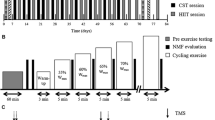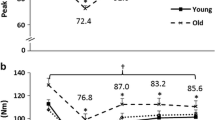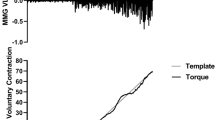Abstract
We examined peripheral versus central contributions to fatigue in men and women during prolonged cycling using a peripheral nerve magnetic stimulation-based technique. 11 men (41 ± 3 years) and 9 women (38 ± 2 years) cycled for 2 h at ventilatory threshold with 5, 1-min sprints interspersed, followed by a 3-km time trial. Quadriceps strength testing was performed isometrically in a semi-reclined position pre- and post-cycling: (1) MVC; (2) MVC with superimposed 3-s magnetic stimulation to measure central activation ratio (CAR), a measure of central fatigue; (3) peripheral magnetic stimulation (PMS) alone of the femoral nerve in a 4-s pulse train, a measure of peripheral fatigue. Data were analyzed with mixed model ANOVA. When adjusted for body mass, men and women had similar strength (p = 0.876), and changes in MVC with time were similar between sexes, declining 22 % in men and 16 % in women (p = 0.360). CAR was similar between sexes and decreased 15 % (effect of time, p < 0.001). Changes in PMS-elicited force were different between sexes: only men lost stimulated strength (6.30 to 5.21 vs. 5.48 to 5.53 N kg−1, interaction p = 0.036). Results clearly demonstrate that quadriceps fatigue after >2 h of cycling was of both central and peripheral origin in men but solely due to central mechanisms in women.




Similar content being viewed by others
Abbreviations
- AUG:
-
Voluntary contraction augmented with superimposed magnetic stimulation
- CAR:
-
Central activation ratio
- MVC:
-
Maximal voluntary contraction
- PMS:
-
Peripheral magnetic stimulation
- RQ:
-
Respiratory quotient
- RPE:
-
Rating of perceived exertion
- VO2 :
-
Oxygen consumption
- VOL:
-
Voluntary contraction
- VT:
-
Ventilatory threshold
References
Albert WJ, Wrigley AT, McLean RB, Sleivert GG (2006) Sex differences in the rate of fatigue development and recovery. Dyn Med 5:2. doi:10.1186/1476-5918-5-2
Borg GA (1982) Psychophysical bases of perceived exertion. Med Sci Sports Exerc 14:377–381
Caiozzo VJ, Davis JA, Ellis JF et al (1982) A comparison of gas exchange indices used to detect the anaerobic threshold. J Appl Physiol 53:1184–1189
Campbell C, Prince D, Braun M et al (2008) Carbohydrate-supplement form and exercise performance. Int J Sport Nutr Exerc Metab 18:179–190
Clark BC, Manini TM, Thé DJ et al (2003) Gender differences in skeletal muscle fatigability are related to contraction type and EMG spectral compression. J Appl Physiol 94:2263–2272. doi:10.1152/japplphysiol.00926.2002
Cureton KJ, Warren GL, Millard-Stafford ML et al (2007) Caffeinated sports drink: ergogenic effects and possible mechanisms. Int J Sport Nutr Exerc Metab 17:35–55
Davis J (1995) Central and peripheral factors in fatigue. J Sports Sci 13(Spec No):S49–S53. doi:10.1080/02640419508732277
Davis J, Alderson N, Welsh R (2000) Serotonin and central nervous system fatigue: nutritional considerations. Am J Clin Nutr 72:573S–578S
de Jonge XAK (2003) Effects of the menstrual cycle on exercise performance. Sports Med 33:833–851
Glace B, McHugh M, Gleim G (1998) Effects of a 2-hour run on metabolic economy and lower extremity strength in men and women. J Orthop Sports Phys Ther 27:189–196
Hunter SK (2009) Sex differences and mechanisms of task-specific muscle fatigue. Exerc Sport Sci Rev 37:113–122. doi:10.1097/JES.0b013e3181aa63e2
Hunter S, Enoka R (2001) Sex differences in the fatigability of arm muscles depends on absolute force during isometric contractions. J Appl Physiol 91:2686–2694
Hunter SK, Schletty JM, Schlachter KM et al (2006) Active hyperemia and vascular conductance differ between men and women for an isometric fatiguing contraction. J Appl Physiol 101:140–150. doi:10.1152/japplphysiol.01567.2005
Jeukendrup AE (2011) Nutrition for endurance sports: marathon, triathlon, and road cycling. J Sports Sci 29(Suppl 1):S91–S99. doi:10(1080/02640414),2011,610348
Kent-Braun JA, Ng AV, Doyle JW, Towse TF (2002) Human skeletal muscle responses vary with age and gender during fatigue due to incremental isometric exercise. J Appl Physiol 93:1813–1823. doi:10.1152/japplphysiol.00091.2002
Kremenic IJ, Ben-Avi SS, Leonhardt D, McHugh MP (2004) Transcutaneous magnetic stimulation of the quadriceps via the femoral nerve. Muscle Nerve 30:379–381. doi:10.1002/mus.20091
Kremenic IJ, Glace BW, Ben-Avi SS et al (2009) Central fatigue after cycling evaluated using peripheral magnetic stimulation. Med Sci Sports Exerc 41:1461–1466. doi:10.1249/MSS.0b013e318199eb75
Larivière C, Gravel D, Gagnon D et al (2006) Gender influence on fatigability of back muscles during intermittent isometric contractions: a study of neuromuscular activation patterns. Clin Biomech (Bristol, Avon) 21:893–904. doi:10.1016/j.clinbiomech.2006.05.004
Lepers R, Hausswirth C, Maffiuletti N et al (2000) Evidence of neuromuscular fatigue after prolonged cycling exercise. Med Sci Sports Exerc 32:1880–1886
Lepers R, Maffiuletti NA, Rochette L et al (2002) Neuromuscular fatigue during a long-duration cycling exercise. J Appl Physiol 92:1487–1493. doi:10.1152/japplphysiol.00880.2001
Martin PG, Rattey J (2007) Central fatigue explains sex differences in muscle fatigue and contralateral cross-over effects of maximal contractions. Pflugers Arch 454:957–969. doi:10.1007/s00424-007-0243-1
Matsui T, Soya S, Okamoto M et al (2011) Brain glycogen decreases during prolonged exercise. J Physiol (Lond) 589:3383–3393. doi:10.1113/jphysiol.2010.203570
Miller AE, MacDougall JD, Tarnopolsky MA, Sale DG (1993) Gender differences in strength and muscle fiber characteristics. Eur J Appl Physiol Occup Physiol 66:254–262
Millet GY, Martin V, Lattier G, Ballay Y (2003) Mechanisms contributing to knee extensor strength loss after prolonged running exercise. J Appl Physiol 94:193–198. doi:10.1152/japplphysiol.00600.2002
Newsholme EA, Blomstrand E (2006) Branched-chain amino acids and central fatigue. J Nutr 136:274S–276S
Nybo L (2003) CNS fatigue and prolonged exercise: effect of glucose supplementation. Med Sci Sports Exerc 35:589–594. doi:10.1249/01.MSS.0000058433.85789.66
Pascual-Leone A, Houser CM, Reese K et al (1993) Safety of rapid-rate transcranial magnetic stimulation in normal volunteers. Electroencephalogr Clin Neurophysiol 89:120–130
Russ DW, Kent-Braun JA (2003) Sex differences in human skeletal muscle fatigue are eliminated under ischemic conditions. J Appl Physiol 94:2414–2422. doi:10.1152/japplphysiol.01145.2002
Russ DW, Lanza IR, Rothman D, Kent-Braun JA (2005) Sex differences in glycolysis during brief, intense isometric contractions. Muscle Nerve 32:647–655. doi:10.1002/mus.20396
Sawka MN, Burke LM, Eichner ER et al (2007) American College of Sports Medicine position stand. Exercise and fluid replacement. Med Sci Sports Exerc 39:377–390. doi:10.1249/mss.0b013e31802ca597
Tarnopolsky M (1998) Gender differences in metabolism: practical and nutritional implications. CRC Press, Boca Raton
Tenaglia SA, McLellan TM, Klentrou PP (1999) Influence of menstrual cycle and oral contraceptives on tolerance to uncompensable heat stress. Eur J Appl Physiol Occup Physiol 80:76–83
Todd G, Taylor JL, Gandevia SC (2003) Measurement of voluntary activation of fresh and fatigued human muscles using transcranial magnetic stimulation. J Physiol (Lond) 551:661–671. doi:10.1113/jphysiol.2003.044099
Twerenbold R, Knechtle B, Kakebeeke TH et al (2003) Effects of different sodium concentrations in replacement fluids during prolonged exercise in women. Br J Sports Med 37:300–303 (discussion 303)
Vagg R, Mogyoros I, Kiernan MC, Burke D (1998) Activity-dependent hyperpolarization of human motor axons produced by natural activity. J Physiol (Lond) 507(Pt 3):919–925
Vandenbogaerde TJ, Hopkins WG (2011) Effects of acute carbohydrate supplementation on endurance performance: a meta-analysis. Sports Med 41:773–792. doi:10.2165/11590520-000000000-00000
Verges S, Maffiuletti NA, Kerherve H et al (2009) Comparison of electrical and magnetic stimulations to assess quadriceps muscle function. J Appl Physiol 106:701–710. doi:10.1152/japplphysiol.01051.2007
Virnig AG, Mcleod CR (1996) Attitudes toward eating and exercise: a comparison of runners and triathletes. J Sport Behav 19:82–90
Yoon T, Schlinder Delap B, Griffith EE, Hunter SK (2007) Mechanisms of fatigue differ after low- and high-force fatiguing contractions in men and women. Muscle Nerve 36:515–524. doi:10.1002/mus.20844
Ethical standards
The experiments performed comply with the current laws of the United States and were approved by the Institutional review Board of Lenox Hill Hospital.
Conflict of interest
The authors declare that they have no conflict of interest.
Author information
Authors and Affiliations
Corresponding author
Additional information
Communicated by Toshio Moritani.
Rights and permissions
About this article
Cite this article
Glace, B.W., Kremenic, I.J. & McHugh, M.P. Sex differences in central and peripheral mechanisms of fatigue in cyclists. Eur J Appl Physiol 113, 1091–1098 (2013). https://doi.org/10.1007/s00421-012-2516-4
Received:
Accepted:
Published:
Issue Date:
DOI: https://doi.org/10.1007/s00421-012-2516-4




